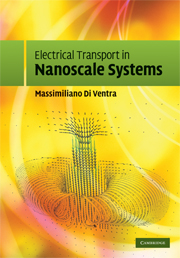Book contents
- Frontmatter
- Contents
- Preface
- 1 A primer on electron transport
- 2 Drude model, Kubo formalism and Boltzmann equation
- 3 Landauer approach
- 4 Non-equilibrium Green's function formalism
- 5 Noise
- 6 Electron-ion interaction
- 7 The micro-canonical picture of transport
- 8 Hydrodynamics of the electron liquid
- Appendices
- References
- Index
6 - Electron-ion interaction
Published online by Cambridge University Press: 06 July 2010
- Frontmatter
- Contents
- Preface
- 1 A primer on electron transport
- 2 Drude model, Kubo formalism and Boltzmann equation
- 3 Landauer approach
- 4 Non-equilibrium Green's function formalism
- 5 Noise
- 6 Electron-ion interaction
- 7 The micro-canonical picture of transport
- 8 Hydrodynamics of the electron liquid
- Appendices
- References
- Index
Summary
Electrical current is affected by the interaction between electrons and ions. Due to this interaction electrons may undergo inelastic transitions between states of different energy, even if the electrons themselves are considered non-interacting with each other. These transitions appear as discontinuities (steps) in the current (conductance) at biases corresponding to the phonon spectrum of the structure. In reality, the phonon spectrum is renormalized by both the electron-phonon interaction at equilibrium, and by the current itself. The latter fact makes the concept of phonons under current flow fundamentally less obvious. I will discuss this point in Sec. 6.5.
An example of inelastic features in nanoscale systems is illustrated in Fig. 6.1 where the conductance of a gold point contact is measured as a function of bias. The conductance shows a step in the range between 10 and 20 meV corresponding to the energy of the vibrational modes of the whole system – gold point contact plus electrodes – that couple more effectively with electrons.
Via the same inelastic mechanism, electrons can exchange energy with the ions and thus heat up the nanostructure while they propagate across it. As we will see later, this phenomenon, called local ionic heating, may have dramatic effects on the stability of nanostructures.
Finally, in a current-carrying system ions may be displaced by local current-induced rearrangements of the electronic distribution – the local resistivity dipoles I discussed in Sec. 3.2 – without the intervention of inelastic processes. The forces responsible for such displacements are known as current-induced forces. Despite many studies, past and present, these forces challenge our understanding of non-equilibrium phenomena, starting from their basic definition for a current-carrying system to their, yet unsolved, conservative character.
- Type
- Chapter
- Information
- Electrical Transport in Nanoscale Systems , pp. 280 - 345Publisher: Cambridge University PressPrint publication year: 2008



